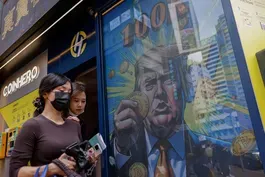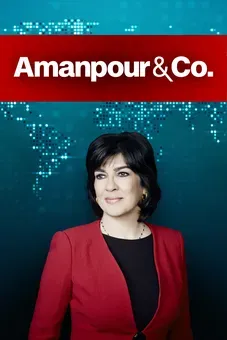
American violinist explores Carnatic music in India
Clip: 5/28/2025 | 7m 20sVideo has Closed Captions
American violinist Ariana Kim visits India to explore Carnatic music
The violin has a storied place in so much of European classical music. But sometime in the 17th century, it began to intrigue maestros from a very different and ancient music tradition. Fred de Sam Lazaro has the story of one American violinist who sought to explore what’s become known as the Carnatic violin. It's for our arts and cultures series, CANVAS.
Problems with Closed Captions? Closed Captioning Feedback
Problems with Closed Captions? Closed Captioning Feedback
Major corporate funding for the PBS News Hour is provided by BDO, BNSF, Consumer Cellular, American Cruise Lines, and Raymond James. Funding for the PBS NewsHour Weekend is provided by...

American violinist explores Carnatic music in India
Clip: 5/28/2025 | 7m 20sVideo has Closed Captions
The violin has a storied place in so much of European classical music. But sometime in the 17th century, it began to intrigue maestros from a very different and ancient music tradition. Fred de Sam Lazaro has the story of one American violinist who sought to explore what’s become known as the Carnatic violin. It's for our arts and cultures series, CANVAS.
Problems with Closed Captions? Closed Captioning Feedback
How to Watch PBS News Hour
PBS News Hour is available to stream on pbs.org and the free PBS App, available on iPhone, Apple TV, Android TV, Android smartphones, Amazon Fire TV, Amazon Fire Tablet, Roku, Samsung Smart TV, and Vizio.
Providing Support for PBS.org
Learn Moreabout PBS online sponsorshipAMNA NAWAZ: The violin has held a storied place in much of European classical music.
But some time in the 17th century, it began to intrigue maestros from a very different and ancient musical tradition, who then adopted it.
This is the story of one American violinist who sought to explore what's become known as the Carnatic violin.
Fred de Sam Lazaro that report from Southern India for our arts and culture series, Canvas.
FRED DE SAM LAZARO: The violinists come from musical traditions as distant as their respective hometowns.
Sumanth Manjunath home is right here in Mysuru, a rising star in Carnatic music who has performed across the world.
Ariana Kim from St. Paul, Minnesota, Grammy nominated, a violin professor at Cornell University, far more familiar with the musical scores of Bach or Handel than this raga in the Carnatic tradition improvised entirely.
Kim is spending a sabbatical in India learning a very different adaptation of her instrument, learning that's taken some unlearning, like posture.
ARIANA KIM, Cornell University: One of the hard things is to resist the temptation to do what my Western sort of muscles and ear want to do, like learning how to use these muscles differently, and using this muscle differently.
FRED DE SAM LAZARO: The instrument sits like an inverted cello, resting on the foot, artist seated on the floor, the traditional tamboura strings here replicated via a phone app.
ARIANA KIM: You just plug it in and it makes this beautiful drone to play against.
And wherever they set that up is their sa.
FRED DE SAM LAZARO: The sa, another adjustment for Kim, tuning her instrument to the Carnatic scale or raga.
ARIANA KIM: So, do, re, mi, fa, sol, la, and si is (SPEAKING IN FOREIGN LANGUAGE).
So they all have a direct equivalent.
FRED DE SAM LAZARO: Not quite that simple.
The scales are, as she puts it, ornamented.
ARIANA KIM: It might sound... (MUSIC) FRED DE SAM LAZARO: Carnatic music is played mostly in South India, the oldest form of Indian classical music, originally intended as devotional, not necessarily entertainment, and oriented toward the human voice.
That likely explains why Carnatic maestros from the 18th and 19th centuries saw the violin as a good fit.
Kim's three weekly sessions are with both Sumanth Manjunath and his father, Mysore Manjunath, one of India's most renowned Carnatic violinists, who was away when we visited.
SUMANTH MANJUNATH, Musician: Beautiful.
Once again.
(MUSIC) SUMANTH MANJUNATH: Yes, there, there is no tension.
You can play it peacefully.
We don't need to make it a little bit faster.
You can also take time when you play.
FRED DE SAM LAZARO: The learning here is oral, though she takes copious notes.
The ancient ragas, if written at all, were only loosely outlined by their composers.
Individual artists improvise and build on them, just as jazz musicians do.
It's a big change for a musician's schooled to faithfully follow notes or scores as the composer wrote them.
ARIANA KIM: I have always had sort of an interest in music from other parts of the world and how symbiotic they can be.
FRED DE SAM LAZARO: A curiosity likely fed by her professional violinist parents, mom from Ohio, dad from Korea.
Here, she's tried to soak up the total experience of getting around in auto rickshaws, sampling the food and nature preserves like this bird sanctuary, a particular favorite of husband Jordan Boersma, an ornithologist also at Cornell.
Just as nature inspired thousands of ragas, she says, the experience here will profoundly inform all her work and future.
ARIANA KIM: It inspires new creativity in the way I think about Bach.
And when I play American bluegrass and old-time music, it makes me think differently about how I might improvise a cadenza in Mozart, and, likewise, the similarities between Korean music, which I studied in my last sabbatical, and Carnatic music, how the gamakas function, how you sort of unveil a raga, how you sort of welcome the audience into a raga.
And you have the responsibility of understanding sort of the tone and the feeling.
Dr. Manjunath and his son, Sumanth, they're just -- they're masters at feeling that internal pulse.
SUMANTH MANJUNATH: Ariana has been grasping all the minute microtones.
FRED DE SAM LAZARO: Sumanth Manjunath was himself complimentary at this recital in the home of a retired Indian diplomat.
SUMANTH MANJUNATH: The amount of observation that she does about the fingering techniques that we play is amazing.
FRED DE SAM LAZARO: She will return home soon and hopes to jam occasionally with Carnatic artists in America, helping preserve memories, including those in the muscles she awakened while learning Carnatic violin.
(MUSIC) FRED DE SAM LAZARO: For the "PBS News Hour," I'm Fred de Sam Lazaro in Mysuru, India.
(MUSIC) (APPLAUSE) SUMANTH MANJUNATH: Wow.
AMNA NAWAZ: Just incredible.
And Fred's reporting is a partnership with the Under-Told Stories Project at the University of St. Thomas in Minnesota.
As dollar takes a hit, Trump family invests heavily in crypto
Video has Closed Captions
Clip: 5/28/2025 | 5m 22s | As dollar takes a hit, Trump family invests heavily in crypto (5m 22s)
News Wrap: Germany to help Ukraine build missile system
Video has Closed Captions
Clip: 5/28/2025 | 7m 30s | News Wrap: Germany's chancellor offers to help Ukraine build long-range missile systems (7m 30s)
The potential impact of Medicaid cuts in Trump's budget bill
Video has Closed Captions
Clip: 5/28/2025 | 6m 8s | Exploring the potential impact of Medicaid cuts in Trump's big budget bill (6m 8s)
Three Mile Island gets new chance to become energy hub
Video has Closed Captions
Clip: 5/28/2025 | 8m 57s | Site of America's worst nuclear accident gets new chance to become energy hub (8m 57s)
Why health groups are concerned about COVID vaccine changes
Video has Closed Captions
Clip: 5/28/2025 | 7m 20s | Why public health groups are concerned about changes to COVID vaccine recommendations (7m 20s)
Why the U.S. is pausing all student visa interviews
Video has Closed Captions
Clip: 5/28/2025 | 9m 34s | Why the U.S. is pausing all student visa interviews (9m 34s)
Providing Support for PBS.org
Learn Moreabout PBS online sponsorshipSupport for PBS provided by:
Major corporate funding for the PBS News Hour is provided by BDO, BNSF, Consumer Cellular, American Cruise Lines, and Raymond James. Funding for the PBS NewsHour Weekend is provided by...

















